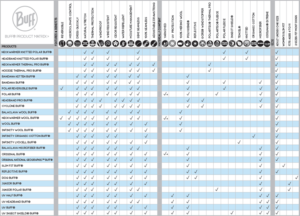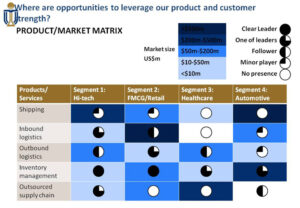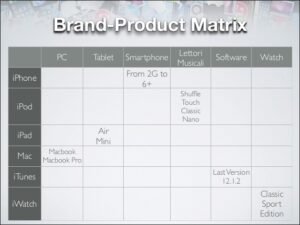What is a product matrix?
How the product matrix can maximize a product line
Is there an opportunity to expand your product line without cannibalizing an item you already sell? Are there features that a current product is missing? Are there too many products in one category? What product should be developed next?
These are the questions that keep product managers up at night. But a product matrix can help provide the answers.
A product matrix is a chart that makes product comparisons easy. It allows you to see a side-by-side comparison of features, prices, market segments and more. The concept sounds simple (and it is), but you can glean a substantial amount of information from it.
Figure out which product to develop next
A lot of money is invested in the development and design of a product before the company makes a single penny. That’s why the decision to create a new product is rarely an easy one to make.
The product matrix can be used to figure out where there are opportunities within a line for product development. You may find that instead of creating an entirely new product it’s more beneficial to create an upgraded version of an existing product. Or you may discover there’s a category with very few products that could introduce your brand to a new market segment.
With the product matrix there are a lot of angles you can take to determine which product should be developed next.
Identify over- and underrepresented product categories
You can quickly see product category trends with a product matrix. It helps you identify the top product categories and whether there are too many or too few products in a category. In circumstances where the product representation is low, you may find that simply offering the same product with different options is an ideal solution. For example, making a product in a different size or color.
It’s possible that the product matrix will reveal some product categories are overrepresented while others are underrepresented. Ideally, the product matrix will help you achieve max product category coverage with the least number of products possible.
See if a market segment is underserved
Listing products by market segment provides another piece of crucial information. It becomes clear which market segments you’re targeting and if there are any segments that are underserved. Those segments represent an opportunity to expand the product line.
Determine if products compliment or compete with each other
Plotting out products using the matrix will quickly show you which products fit in the same category and/or have the same features. From there, you can drill down to determine if a product adds equity to the other items in the category or competes with them.
Help explain product differentiation
If you have two or more products that are similar it can get confusing for customers. The best option may not be readily apparent. It’s up to marketers to identify the differentiators and position the products accordingly. A product matrix that highlights product features will aid in this effort.
A word about brand-product matrix
There’s another matrix you may have heard of – the brand-product matrix. It’s a variation that helps visualize all of the products for a brand and examine the product line as a whole. The goal is to show the brand-product relationship, create a product marketing strategy and find areas where the product line can be expanded.
Large corporations with multiple brands can also use the brand-product matrix to list all of the products for each brand and look at them collectively. It will quickly show where there’s overlap and gaps in the product lines as well as the relationship to the parent brand. The product-brand matrix can also help a corporation decide whether or not to start a new brand to serve a specific market segment.
Creating a product matrix
A product matrix is easy to create and can be done with a standard spreadsheet. Each row should represent a product and the columns are different parameters that may or may not apply to a product.
One of the advantages of using a product matrix is it can be customized to better reflect your product line and business goals by adding different parameters. You can also drill down and create a matrix for each parameter.
Common product matrix parameters
Product category
A product category is a group of products that share some sort of characteristic, such as:
- Functioning in a similar manner
- Being bought by the same customer segment
- Marketed through the same channels
- Having the same price range
*A product mix is all of the products a business sells across all categories.
Product type
These are the various segments of products in the same category. Product types should be defined from an end-user perspective. It’s best practice to have no more than six product types in a category.
Product features
The features are all of the distinct characteristics of a product. They commonly refer to functionality.
Product design
The product design refers to how a product looks. Examples of what would be included as product design are color, material and finish.
Product matrix examples
Product matrix for features

Product matrix for market segments

Product matrix for product type

Final thoughts
Using a product matrix puts things in perspective so that product development is more efficient and the line is diverse rather than repetitive. It’s the 1,000-foot view that takes all of the product essentials into consideration so they can be compared side-by-side. Ultimately, a simple product matrix chart should help product managers better manage their product portfolio so that R&D costs are minimized and market coverage is maximized.


